New Bioretention Drainage Channel as One of the Low-Impact Development Solutions: A Case Study from Poland
Abstract
1. Introduction
2. Materials and Methods
2.1. Research Stages
2.2. Characteristics of a New Bioretention Drainage Channel Solution
2.3. A prototype of a Bioretention Drainage Channel
- Filter-insert: 30 cm × 30 cm × 100 cm, the diameter of the holes in the bottom is 15 mm.
- Outer housing: 35 cm × 50 cm × 105 cm, the diameter of holes in the bottom is 20 mm.
- Stable and long-lasting plant vegetation,
- Water for the proper development of the plants,
- Drainage of excess water into the drainage layer,
- Proper aeration of plant roots,
- Resistance to subsidence (mineralisation),
- Resistance to weather conditions (frost, wind),
- Optimal content of organic components necessary for proper plant growth.
2.4. Laboratory Tests of the Bioretention Drainage Channel
2.5. Modelling a Bioretention Drainage Channel—Case Study
3. Results and Discussion
3.1. Laboratory Research of Bioretention Drainage Channels
3.2. Hydrodynamic Research of BRC
4. Conclusions
- The designed construction of the BRC fulfilled its intended primary function, which is the pre-treatment of rainwater.
- The BRC was characterised by very high efficiency in removing environmentally and humanly harmful petroleum hydrocarbons from rainwater, where the degree of reduction of these pollutants was almost 100%.
- The degree of reduction in the concentration of total suspended solids was also high, averaging 69% and 57% for prototypes K1 and K2, respectively.
- The modular design of the bioretention drainage channel makes it possible to create structures of any size to suit local terrain conditions and rainwater volumes.
- The designed channel is a compact device with a smaller surface area than other objects with similar functions, such as infiltration basins.
- Plants such as Pennisetum alopecuroides, Heuchera x hybrida, Echinacea, and Carex are suitable species for planting in the bioretention drainage channel.
- The BRCs were characterised by very high retention and infiltration efficiencies, and their implementation in the catchment improved the hydrological parameters of the catchment.
- The implementation of the BRCs in the catchment made it possible to achieve a high degree of reduction of flows in the sewerage network (83%). It can be important in cases of connecting new catchments to the sewerage systems, which are often hydraulically overloaded in their current state.
Author Contributions
Funding
Data Availability Statement
Conflicts of Interest
References and Notes
- Cousins, J. Of floods and droughts: The uneven politics of stormwater in Los Angeles. Polit. Geogr. 2017, 60, 34–36. [Google Scholar] [CrossRef]
- Jato-Espino, D.; Toro-Huertas, E.; Guereca, L. Lifecycle sustainability assessment for the comparison of traditional and sustainable drainage systems. Sci. Total Environ. 2022, 817, 152959. [Google Scholar] [CrossRef] [PubMed]
- Müller, A.; Österlund, H.; Marsalek, J.; Viklander, M. The pollution conveyed by urban runoff: A review of sources. Sci. Total Environ. 2020, 709, 136125. [Google Scholar] [CrossRef]
- Qin, Y. Urban Flooding Mitigation Techniques: A Systematic Review and Future Studies. Water 2020, 12, 3579. [Google Scholar] [CrossRef]
- Xu, D.; Ouyang, Z.; Wu, T.; Han, B. Dynamic Trends of Urban Flooding Mitigation Services in Shenzhen, China. Sustainability 2020, 12, 4799. [Google Scholar] [CrossRef]
- Dhakal, K.; Chevalier, L. Managing urban stormwater for urban sustainability: Barriers and policy solutions for green infrastructure application. J. Environ. Manag. 2017, 203, 171–181. [Google Scholar] [CrossRef] [PubMed]
- Doeffinger, T.; Rubinyi, S. Secondary benefits of urban flood protection. J. Environ. Manag. 2023, 326, 116617. [Google Scholar] [CrossRef]
- Qiao, X.-J.; Kristoffersson, A.; Randrup, T. Challenges to implementing urban sustainable stormwater management from a governance perspective: A literature review. J. Clean. Prod. 2018, 196, 943–952. [Google Scholar] [CrossRef]
- Directive 2000/60/EC of the European Parliament and of the Council of 23 October 2000 Establishing a Framework for Community Action in the Field of Water Policy. Available online: https://eur-lex.europa.eu/eli/dir/2000/60/oj (accessed on 20 April 2023).
- Gao, Y.; Babin, N.; Turner, A.; Hoffa, C.; Peel, S.; Prokopy, L. Understanding urban-suburban adoption and maintenance of rain barrels. Landsc. Urban Plan. 2016, 153, 99–110. [Google Scholar] [CrossRef]
- You, J.; Chen, X.; Chen, L.; Chen, J.; Chai, B.; Kang, A.; Lei, X.; Wang, S. A Systematic Bibliometric Review of Low Impact Development Research Articles. Water 2022, 14, 2675. [Google Scholar] [CrossRef]
- Pochwat, K.; Pizzo, H. Analysis of the Hydraulic Efficiency of a Steerable Detention Tank—Simulation Studies. Hydrology 2022, 9, 217. [Google Scholar] [CrossRef]
- Pochwat, K. Assessment of Rainwater Retention Efficiency in Urban Drainage Systems—Model Studies. Resources 2022, 11, 14. [Google Scholar] [CrossRef]
- Liu, T.; Lawluvy, Y.; Shi, Y.; Yap, P.-S. Low Impact Development (LID) Practices: A Review on Recent Developments, Challenges and Prospects. Water Air Soil Pollut. 2021, 232, 344. [Google Scholar] [CrossRef]
- Kordana-Obuch, S.; Starzec, M.; Słyś, D. Evaluation of the Influence of Catchment Parameters on the Required Size of a Stormwater Infiltration Facility. Water 2023, 15, 191. [Google Scholar] [CrossRef]
- Imteaz, M.; Moniruzzaman, M. Potential impacts of climate change on future rainwater tank outcomes: A case study for Sydney. J. Clean. Prod. 2020, 273, 123095. [Google Scholar] [CrossRef]
- Imteaz, M.A.; Boulomytis, V.T.G.; Yilmaz, A.G.; Shanableh, A. Water Quality Improvement through Rainwater Tanks: A Review and Simulation Study. Water 2022, 14, 1411. [Google Scholar] [CrossRef]
- Bonneau, J.; Kouyi, G.; Lassabatere, L.; Fletcher, T. Field validation of a physically-based model for bioretention systems. J. Clean. Prod. 2021, 312, 127636. [Google Scholar] [CrossRef]
- Lee, J.; Bang, K. Characterization of urban stormwater runoff. Water Res. 2000, 34, 1773–1780. [Google Scholar] [CrossRef]
- Wang, S.; He, Q.; Ai, H.; Wang, Z.; Zhang, Q. Pollutant concentrations and pollution loads in stormwater runoff from different land uses in Chongqing. J. Environ. Sci. 2013, 25, 502–510. [Google Scholar] [CrossRef]
- Wang, J.; Huang, J.; Li, J. Characterization of the pollutant build-up processes and concentration/mass load in road deposited sediments over a long dry period. Sci. Total Environ. 2020, 718, 137282. [Google Scholar] [CrossRef]
- Shen, Z.; Liu, J.; Aini, G.; Gong, Y. A comparative study of the grain-size distribution of surface dust and stormwater runoff quality on typical urban roads and roofs in Beijing, China. Environ. Sci. Pollut. Res. 2016, 23, 2693–2704. [Google Scholar] [CrossRef] [PubMed]
- Hu, D.; Zhang, C.; Ma, B.; Liu, Z.; Yang, X.; Yang, L. The characteristics of rainfall runoff pollution and its driving factors in Northwest semiarid region of China—A case study of Xi’an. Sci. Total Environ. 2020, 726, 138384. [Google Scholar] [CrossRef] [PubMed]
- Barałkiewicz, D.; Chudzińska, M.; Szpakowska, B.; Świerk, D.; Gołdyn, R.; Dondajewska, R. Storm water contamination and its effect on the quality of urban surface waters. Environ. Monit. Assess. 2014, 186, 6789–6803. [Google Scholar] [CrossRef] [PubMed]
- Bakr, A.; Fu, G.; Hedeen, D. Water quality impacts of bridge stormwater runoff from scupper drains on receiving waters: A review. Sci. Total Environ. 2020, 726, 138068. [Google Scholar] [CrossRef]
- Palla, A.; Gnecco, I. Hydrologic modeling of Low Impact Development systems at the urban catchment scale. J. Hydrol. 2015, 528, 361–368. [Google Scholar] [CrossRef]
- Zhang, K.; Chui, T.F. Linking hydrological and bioecological benefits of green infrastructures across spatial scales—A literature review. Sci. Total Environ. 2019, 646, 1219–1231. [Google Scholar] [CrossRef] [PubMed]
- Saini, S.; Singh, A. Modeling LID using SWMM5 and MIDS Credit Calculator: Credit Valley Conservation’s Elm Drive Case Study. J. Water Manag. Model. 2016, 24, C403. [Google Scholar] [CrossRef]
- Dutta, A.; Torres, A.S.; Vojinovic, Z. Evaluation of Pollutant Removal Efficiency by Small-Scale Nature-Based Solutions Focusing on Bio-Retention Cells, Vegetative Swale and Porous Pavement. Water 2021, 13, 2361. [Google Scholar] [CrossRef]
- Shrestha, P.; Hurley, S.; Wemple, B. Effects of different soil media, vegetation, and hydrologic treatments on nutrient and sediment removal in roadside bioretention systems. Ecol. Eng. 2018, 112, 116–131. [Google Scholar] [CrossRef]
- Mahmoud, A.; Alam, T.; Rahman, Y.; Sanchez, A.; Guerrero, J.; Jones, K. Evaluation of field-scale stormwater bioretention structure flow and pollutant load reductions in a semi-arid coastal climate. Ecol. Eng. 2019, 142, 100007. [Google Scholar] [CrossRef]
- Chen, X.; Peltier, E.; Sturm, B.S.M.; Young, C.B. Nitrogen removal and nitrifying and denitrifying bacteria quantification in a stormwater bioretention system. Water Res. 2013, 47, 1691–1700. [Google Scholar] [CrossRef]
- Liu, J.; Sample, D.J.; Bell, C.; Guan, Y. Review and Research Needs of Bioretention Used for the Treatment of Urban Stormwater. Water 2014, 6, 1069–1099. [Google Scholar] [CrossRef]
- Pivetta, G.G.; Tassi, R.; Piccilli, D.G.A. Evaluating bioretention scale effect on stormwater retention and pollutant removal. Environ Sci. Pollut. Res. 2023, 30, 15561–15574. [Google Scholar] [CrossRef] [PubMed]
- Søberg, L.; Viklander, M.; Blecken, G.-T.; Hedström, A. Reduction of Escherichia coli, Enterococcus faecalis and Pseudomonas aeruginosa in stormwater bioretention: Effect of drying, temperature and submerged zone. J. Hydrol. X 2019, 3, 100025. [Google Scholar] [CrossRef]
- Greksa, A.; Grabić, J.; Blagojević, B. Contribution of low impact development practices-bioretention systems towards urban flood resilience: Case study of Novi Sad, Serbia. Environ. Eng. Res. 2022, 27, 210125. [Google Scholar] [CrossRef]
- De Macedo, M.B.; do Lago, C.A.F.; Mendiondo, E.M. Stormwater volume reduction and water quality improvement by bioretention: Potentials and challenges for water security in a subtropical catchment. Sci. Total Environ. 2019, 647, 923–931. [Google Scholar] [CrossRef]
- Kordana, S.; Słyś, D. An analysis of important issues impacting the development of stormwater management systems in Poland. Sci. Total Environ. 2020, 727, 138711. [Google Scholar] [CrossRef]
- Sakson, G.; Brzezińska, A.; Zawilski, M. Możliwości Ograniczenia Wpływu Ścieków Deszczowych Odprowadzanych z Obszarów Zurbanizowanych na Jakość Wód Powierzchniowych w Aspekcie Uregulowań Prawnych (Prospects for Reduction of the Impact of Wastewater Discharge from Urban Areas on Surface Water Quality in View of Legal Regulations). Ochr. Sr. 2017, 39, 27–38. Available online: https://yadda.icm.edu.pl/baztech/element/bwmeta1.element.baztech-24150dd5-d34e-46c7-a1d7-f5def145a530 (accessed on 20 April 2023).
- Słyś, D.; Stec, A.; Piotrowska, B. Koryto Odwodnieniowe. Patent No. 440938, 2023. Urząd Patentowy Rzeczypospolitej Polskiej, Warszawa (Bio-retention drainage channel. Patent No. 440938. Patent Office of the Republic of Poland, Warsaw).
- Rozporządzenie Ministra Gospodarki Morskiej i Żeglugi Śródlądowej z dnia 12 lipca 2019 r. w sprawie substancji szczególnie szkodliwych dla środowiska wodnego oraz warunków, jakie należy spełnić przy wprowadzaniu do wód lub do ziemi ścieków, a także przy odprowadzaniu wód opadowych lub roztopowych do wód lub do urządzeń wodnych (Regulation on substances particularly harmful to the water environment and the conditions to be met when introducing sewage into waters or into the ground, as well as when discharging rainwater or meltwater into waters or water facilities). Dz.U. 2019 poz. 1311.
- PN-EN 872:2007 + Ap1:2007 (A); Jakość Wody. Oznaczanie Zawiesin. Metoda z Zastosowaniem Filtracji Przez Sączki z Włókna Szklanego (Water Quality. Determination of Suspensions. Method Using Filtration through Glass Fiber Filters).
- PN-EN ISO 9377-2:2003 (A); Jakość Wody. Oznaczanie Indeksu Oleju Mineralnego. Część 2: Metoda z Zastosowaniem Ekstrakcji Rozpuszczalnikiem i Chromatografii Gazowej (Water Quality. Determination of the Mineral Oil Index. Part 2: Method Using Solvent Extraction and Gas Chromatography).
- USEPA. Storm Water Management Model, Version 5.2.3 with Low Impact Development (LID) Controls. Available online: https://www.epa.gov/water-research/storm-water-management-model-swmm (accessed on 15 March 2023).
- Storm Water Management Model User’s Manual Version 5.2. Available online: https://www.epa.gov/system/files/documents/2022-04/swmm-users-manual-version-5.2.pdf (accessed on 15 March 2023).
- Bai, Y.; Li, Y.; Zhang, R.; Zhao, N.; Zeng, X. Comprehensive Performance Evaluation System Based on Environmental and Economic Benefits for Optimal Allocation of LID Facilities. Water 2019, 11, 341. [Google Scholar] [CrossRef]
- Bond, J.; Batchabani, E.; Fuamba, M.; Courchesne, D.; Trudel, G. Modeling a Bioretention Basin and Vegetated Swale with a Trapezoidal Cross Section using SWMM LID Controls. J. Water Manag. Model. 2021, 29, C474. [Google Scholar] [CrossRef]
- Nazarpour, S.; Gnecco, I.; Palla, A. Evaluating the Effectiveness of Bioretention Cells for Urban Stormwater Management: A Systematic Review. Water 2023, 15, 913. [Google Scholar] [CrossRef]
- Gilbreath, A.; McKee, L.; Shimabuku, I.; Lin, D.; Werbowski, L.M.; Zhu, X.; Grbic, J.; Rochman, C. Multiyear water quality performance and mass accumulation of PCBs, mercury, methylmercury, copper, and microplastics in a bioretention rain garden. J. Sustain. Water Built Environ. 2019, 5, 04019004. [Google Scholar] [CrossRef]
- Winston, R.; Dorsey, J.; Hunt, W. Quantifying volume reduction and peak flow mitigation for three bioretention cells in clay soils in northeast Ohio. Sci. Total Environ. 2016, 553, 83–95. [Google Scholar] [CrossRef] [PubMed]
- Kandel, S.; Vogel, J.; Penn, C.; Brown, G. Phosphorus retention by fly ash amended filter media in aged bioretention cells. Water 2017, 9, 746. [Google Scholar] [CrossRef]
- Willard, L.; Wynn-Thompson, T.; Krometis, L.; Neher, T.; Badgley, B. Does it pay to be mature? Evaluation of bioretention cell performance seven years postconstruction. J. Environ. Eng. 2017, 143, 04017041. [Google Scholar] [CrossRef]
- Avellaneda, P.M.; Jefferson, A.J.; Grieser, J.M.; Bush, S.A. Simulation of the cumulative hydrological response to green infrastructure. Water Resour. Res. 2017, 53, 3087–3101. [Google Scholar] [CrossRef]
- Wałęga, A.; Cebulska, M.; Gądek, W. The use of bioretention cell to decreasing outflow from parking lot. J. Water Land Dev. 2018, 36, 173–181. [Google Scholar] [CrossRef]

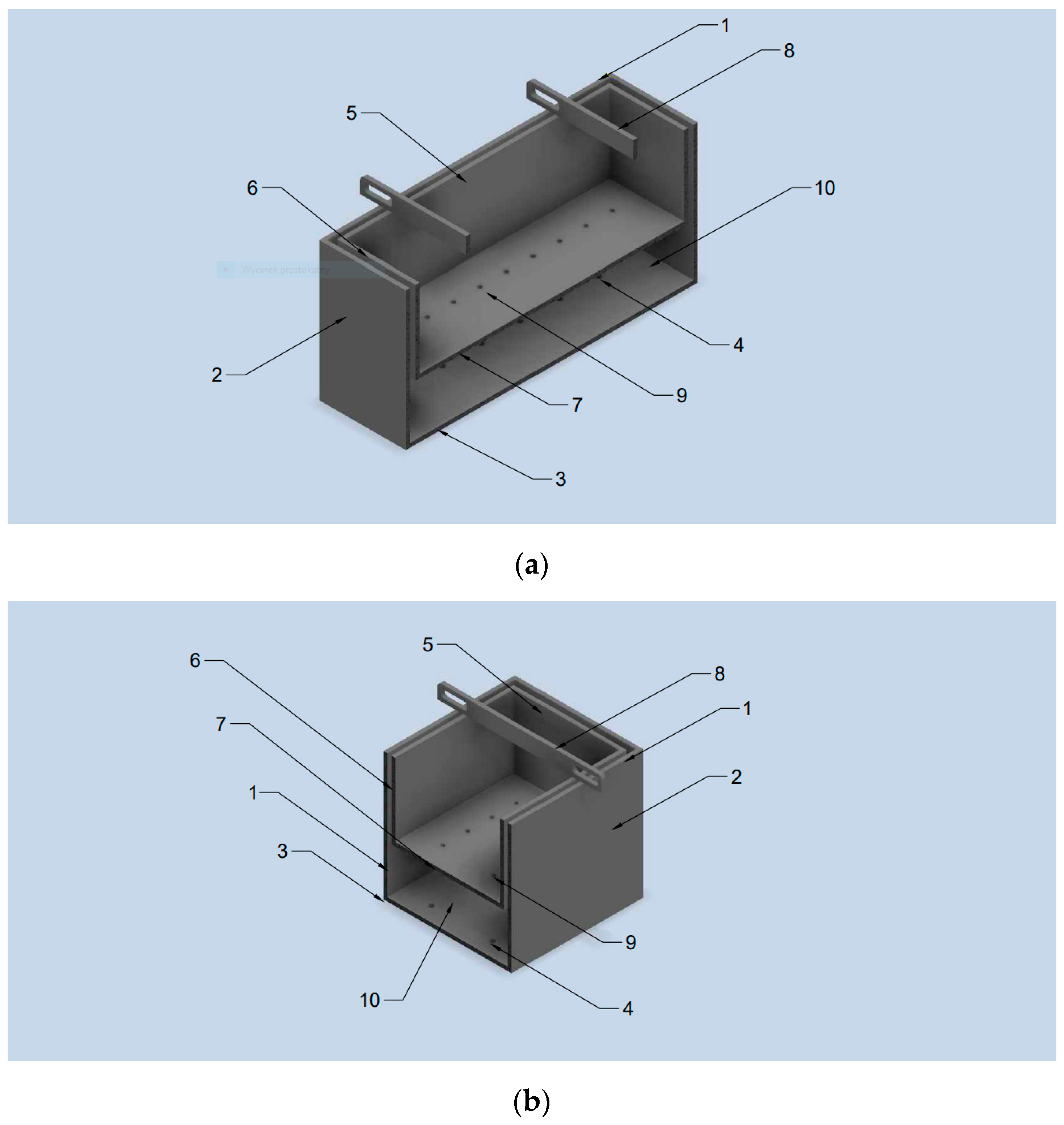
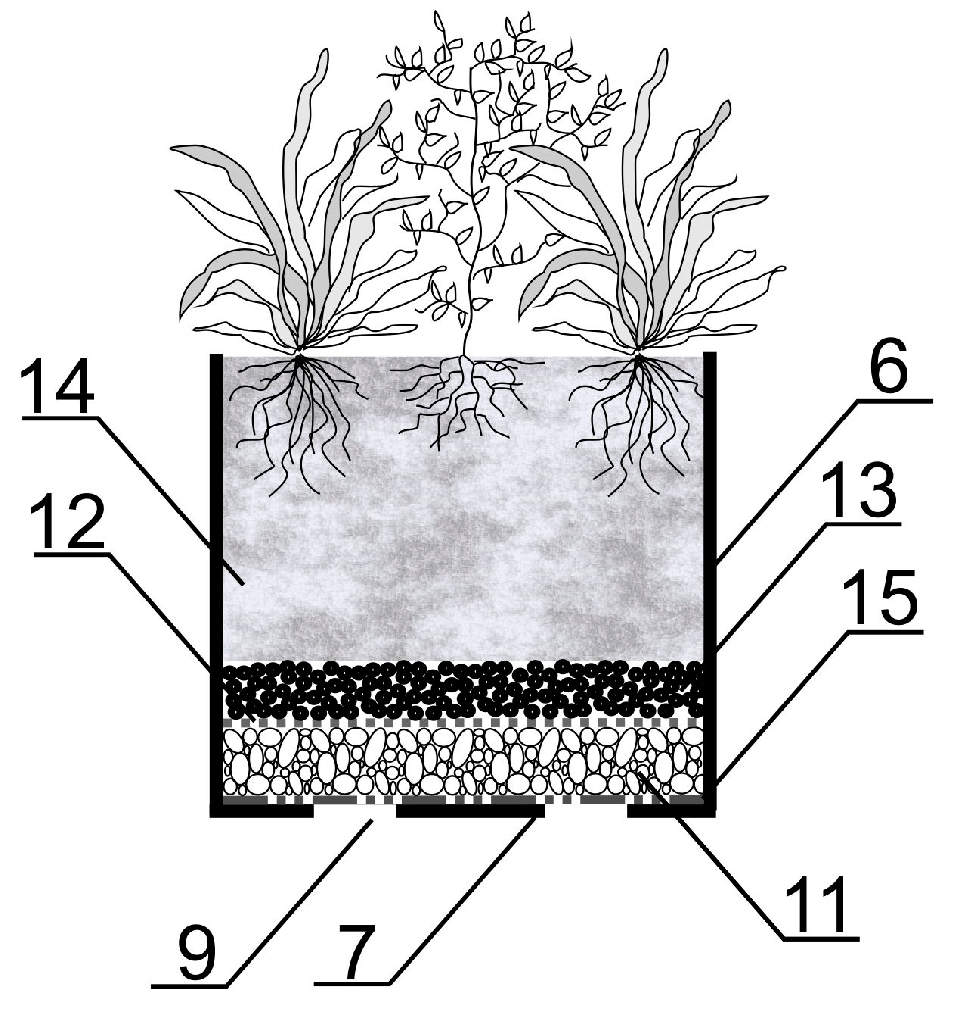
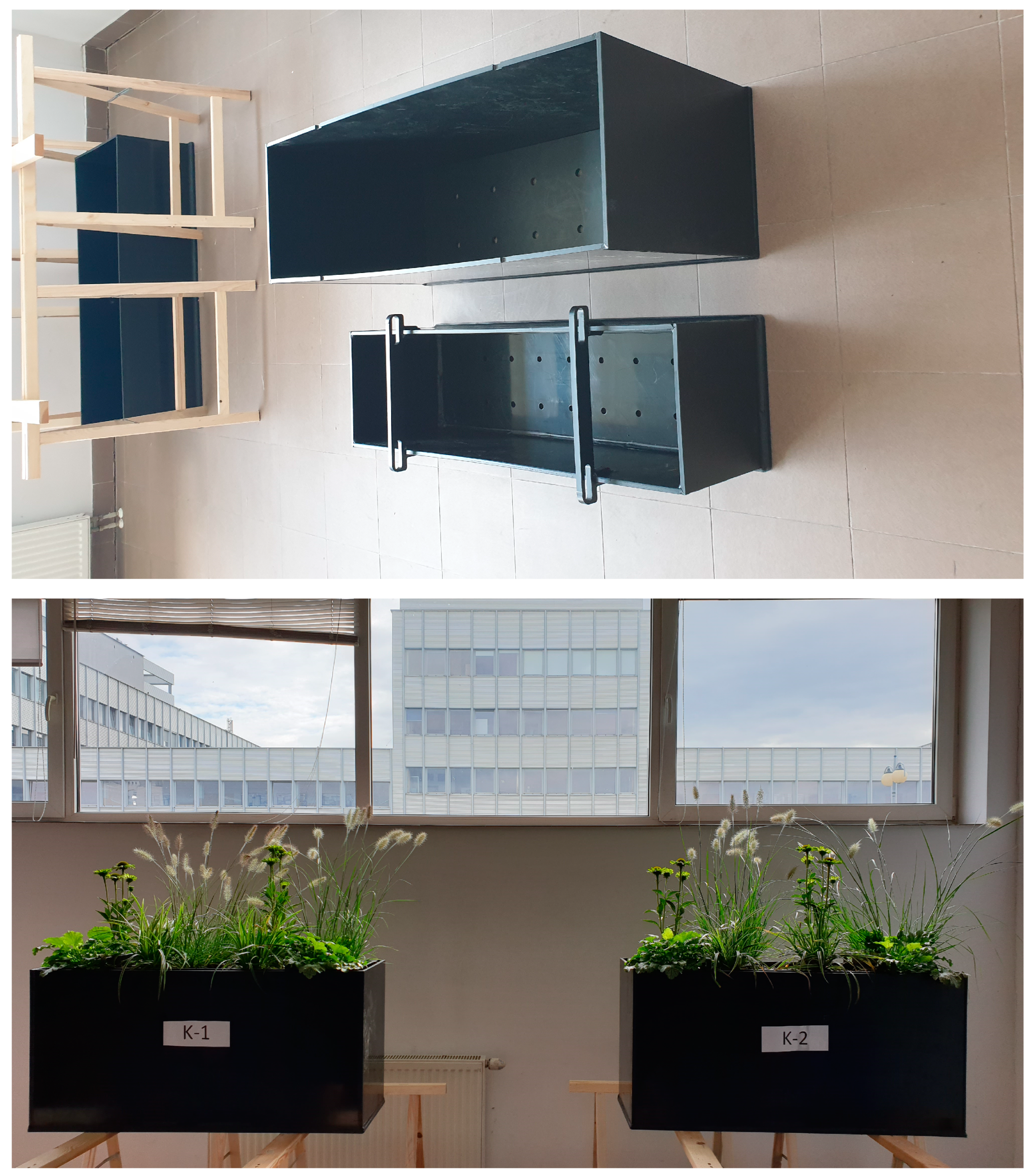


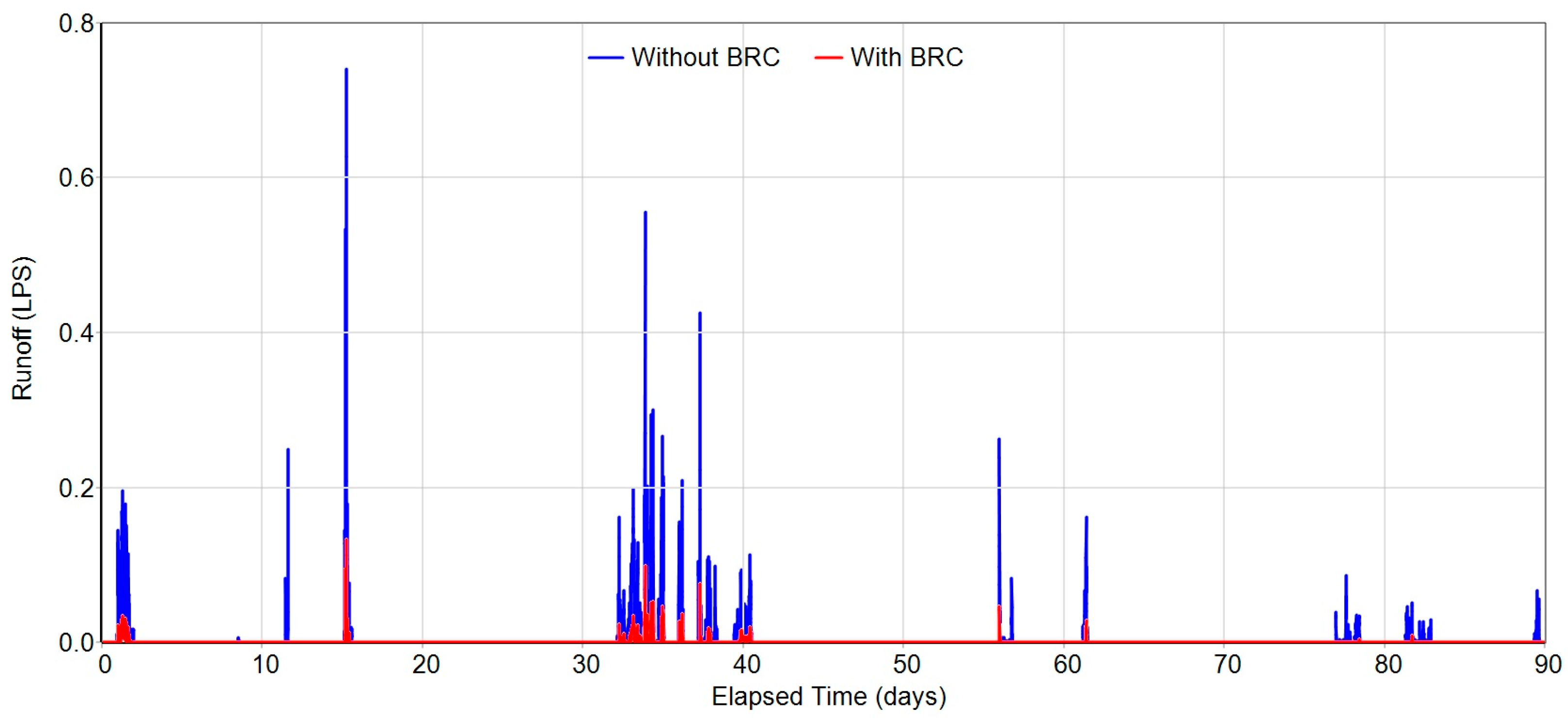
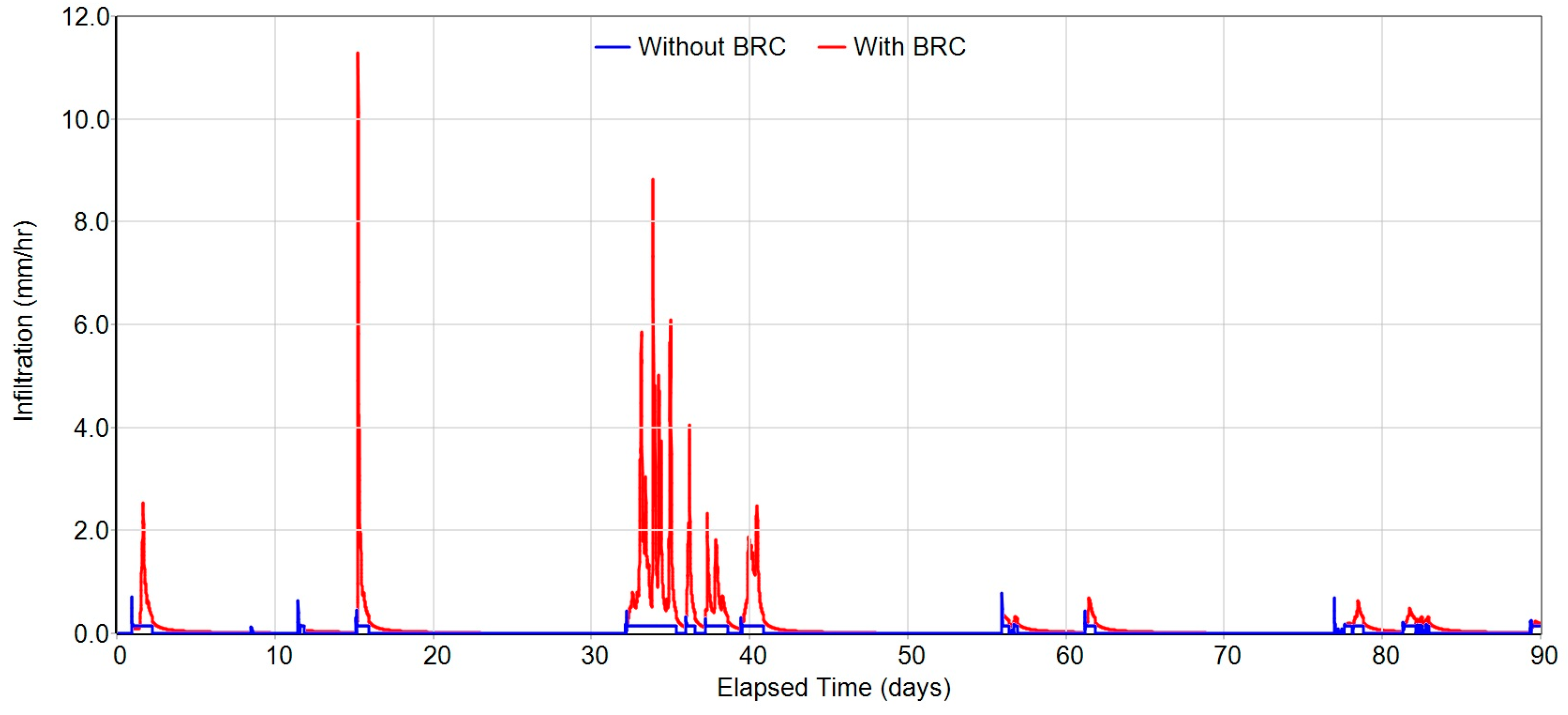
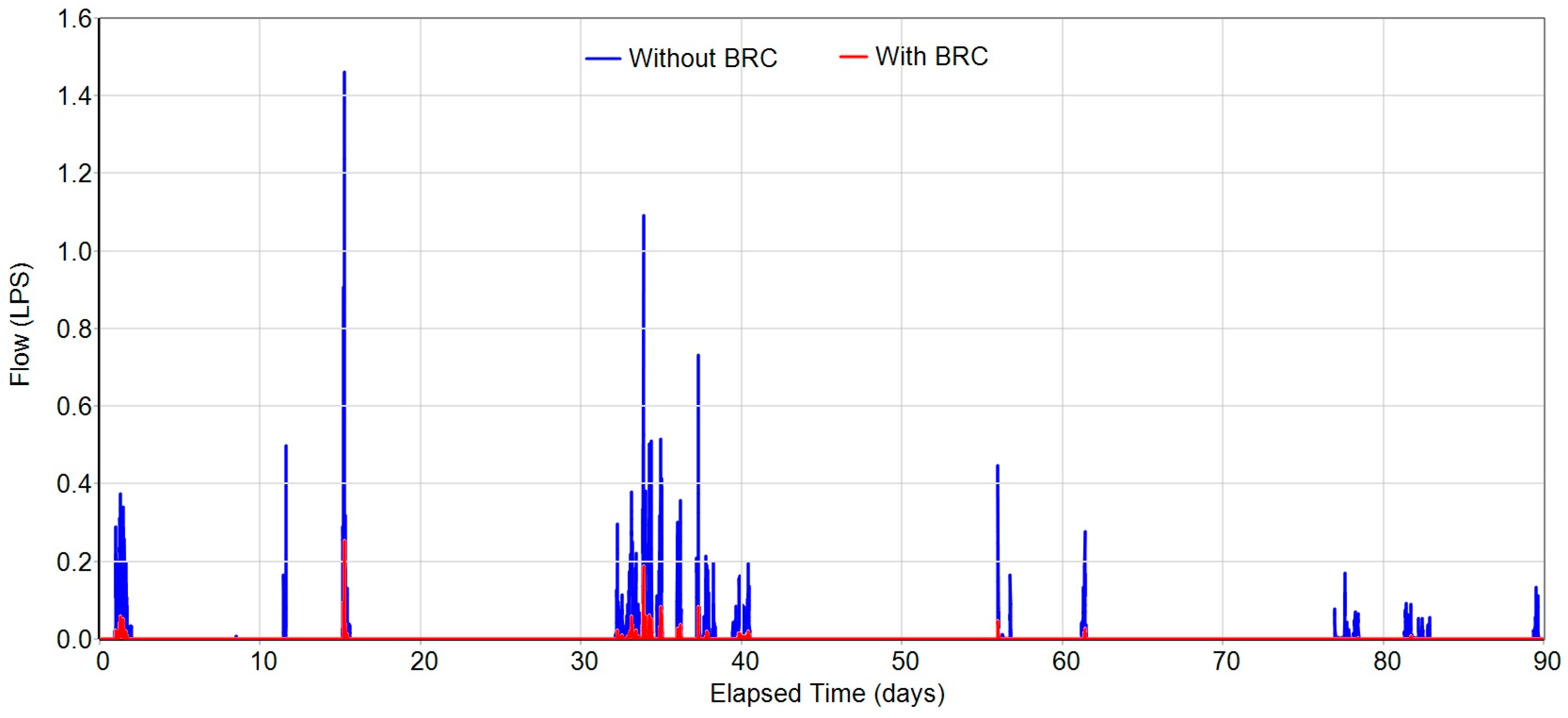
| Parameter | Value |
|---|---|
| Land surface slope, % | 2 |
| Manning’s coefficient for impervious surfaces | 0.013 |
| Manning’s coefficient for pervious surfaces | 0.15 |
| Impervious depression storage, mm | 2 |
| Pervious depression storage, mm | 4 |
| Percent imperviousness, % | 70 |
| Parameter | Value |
|---|---|
| Surface layer | |
| Berm height (mm) | 250 |
| Vegetation volume | 0.2 |
| Surface roughness | 0.13 |
| Surface slope (%) | 1 |
| Soil layer | |
| Soil thickness (mm) | 300 |
| Hydraulic conductivity (mm/h) | 250 |
| Suction head (mm) | 50 |
| Porosity | 0.6 |
| Field capacity | 0.5 |
| Wilting point | 0.2 |
| Conductivity slope | 44 |
| Storage layer | |
| Thickness (mm) | 50 |
| Void ratio (voids/solids) | 0.3 |
| Seepage rate (mm/h) | 28 |
| Clogging factor | 0 |
| Sample | Bioretention Drainage Channel K1 | Bioretention Drainage Channel K2 | ||
|---|---|---|---|---|
| Total Suspended Solids Concentration ZK1, mg/L | Concentration of Petroleum Hydrocarbons WK1, mg/L | Total Suspended Solids Concentration ZK2, mg/L | Concentration of Petroleum Hydrocarbons WK2, mg/L | |
| 1 * | 102 | <0.10 | 105 | <0.10 |
| 2 * | 129 | <0.10 | 186 | <0.10 |
| 3 | 168 | <0.10 | 293 | <0.10 |
| 4 | 139 | <0.10 | 211 | <0.10 |
| 5 | 175 | <0.10 | 346 | <0.10 |
| 6 | 274 | <0.10 | 336 | <0.10 |
| 7 | 163 | <0.10 | 382 | <0.10 |
| 8 | 143 | <0.10 | 341 | <0.10 |
| Sample | Bioretention Drainage Channel K1 | Bioretention Drainage Channel K2 | ||
|---|---|---|---|---|
| Total Suspended Solids Concentration CZK1, mg/L | Concentration of Petroleum Hydrocarbons WK1, mg/L | Total Suspended Solids Concentration CZK2, mg/L | Concentration of Petroleum Hydrocarbons WK2, mg/L | |
| 3 | 52.5 | <0.10 | 147.5 | <0.10 |
| 4 | 23.5 | <0.10 | 65.5 | <0.10 |
| 5 | 59.5 | <0.10 | 200.5 | <0.10 |
| 6 | 158.5 | <0.10 | 190.5 | <0.10 |
| 7 | 47.5 | <0.10 | 236.5 | <0.10 |
| 8 | 27.5 | <0.10 | 195.5 | <0.10 |
| Sample | Bioretention Drainage Channel K1 | Bioretention Drainage Channel K2 | ||
|---|---|---|---|---|
| Total Suspended Solids, % | Petroleum Hydrocarbons, % | Total Suspended Solids, % | Petroleum Hydrocarbons, % | |
| 3 | 74 | ~100 | 63 | ~100 |
| 4 | 88 | ~100 | 84 | ~100 |
| 5 | 70 | ~100 | 50 | ~100 |
| 6 | 21 | ~100 | 52 | ~100 |
| 7 | 76 | ~100 | 41 | ~100 |
| 8 | 86 | ~100 | 51 | ~100 |
Disclaimer/Publisher’s Note: The statements, opinions and data contained in all publications are solely those of the individual author(s) and contributor(s) and not of MDPI and/or the editor(s). MDPI and/or the editor(s) disclaim responsibility for any injury to people or property resulting from any ideas, methods, instructions or products referred to in the content. |
© 2023 by the authors. Licensee MDPI, Basel, Switzerland. This article is an open access article distributed under the terms and conditions of the Creative Commons Attribution (CC BY) license (https://creativecommons.org/licenses/by/4.0/).
Share and Cite
Stec, A.; Słyś, D. New Bioretention Drainage Channel as One of the Low-Impact Development Solutions: A Case Study from Poland. Resources 2023, 12, 82. https://doi.org/10.3390/resources12070082
Stec A, Słyś D. New Bioretention Drainage Channel as One of the Low-Impact Development Solutions: A Case Study from Poland. Resources. 2023; 12(7):82. https://doi.org/10.3390/resources12070082
Chicago/Turabian StyleStec, Agnieszka, and Daniel Słyś. 2023. "New Bioretention Drainage Channel as One of the Low-Impact Development Solutions: A Case Study from Poland" Resources 12, no. 7: 82. https://doi.org/10.3390/resources12070082
APA StyleStec, A., & Słyś, D. (2023). New Bioretention Drainage Channel as One of the Low-Impact Development Solutions: A Case Study from Poland. Resources, 12(7), 82. https://doi.org/10.3390/resources12070082







